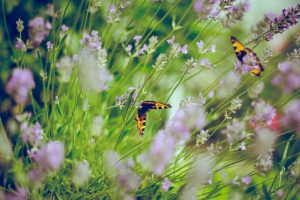Houseplants are an easy way to bring your apartment from drab to fab and make your space feel more homey. Keeping houseplants around is not only aesthetically pleasing but can have great psychological and physical benefits for you too. Studies have shown that people who take care of plants have reduced stress levels and boosted overall moods!
This may not be a definitive list – there are so many houseplants to love! – but we took a look at the amazing houseplants we have here at our Utah nursery and picked out ones that would be particularly great for apartment dwellers. Whether you live in a cozy studio or have more space to work with, these plants will look great and are easy to take care of.
Burgundy Ficus
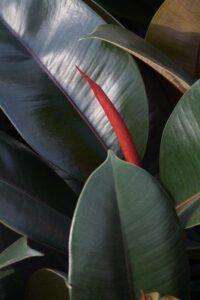 About The Plant
About The Plant
The Burgundy Ficus AKA Ficus Elastica Burgundy is a plant known for its fleshy dark green and burgundy leaves. It is, of course, a member of the Ficus tree family which you may have heard referred to as Rubber Trees. The plant is native to South Asia and has since been naturalized in other parts of the world including Florida.
Fun Fact: When left to its own devices in the wild, the Burgundy Ficus can grow up to 100 feet – but don’t worry – your houseplant will stay an apartment-friendly size!
Burgundy Ficus Care Notes:
Burgundy Ficus is a durable and low-maintenance plant. Still, taking proper care will ensure a more beautiful and healthy ficus. To maximize the reddish color of the leaves, keep the plant at its happiest by making sure it gets plenty of sunlight throughout the day. Place it near a big window facing south if you can!
This Ficus doesn’t need a whole lot of water. As a best practice, feel 2-3 inches into the dirt with your finger. If it feels dry, it is time to give it some H20.
Neon Pink Arrowhead
About the Plant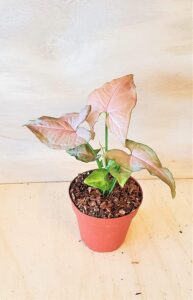
Arrowhead plants are among the most popular houseplants to have. If you’re on the hunt for a plant to provide a pop of color, pick up a Neon Pink Arrowhead, also known as Pink Syngonium. This hardy evergreen has beautiful heart-shaped pink leaves that are as pretty as they are hardy.
The Neon Pink Arrowhead does have vines that will want to climb, but if that doesn’t work for your space, they are easy to keep in check.
Neon Pink Arrowhead Care Notes
These fetching houseplants are also super easy to care for. They’re tolerant of low light, but if you want them to thrive, try to make sure they get medium to bright indirect light. You mostly want to avoid direct sunlight, which will burn up those lovely pink leaves.
When watering, err on the side of caution. Less is more! Neon Pink Arrowhead plants prefers lightly moist soil. Under the right conditions, they are very fast-growing, so you may want to prune regularly.
It’s also worth noting that this plant does have poisonous properties if ingested, so keep away curious pets and children!
ZZ Lucky Giant Leaf
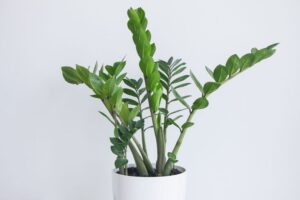 About The Plant
About The Plant
ZZ Plants – or Zamioculcas zamiifolia if you want more of a mouthful – are beloved for being stunning and nearly impossible to kill. The plants are native to Southern Africa. In the ‘90s, Dutch nurseries realized ZZ Plants had great propagating potential and began to distribute them worldwide.
The Lucky Giant Leaf variety grows taller than its counterparts – but not too tall for an apartment! At 3-4 feet tall, it will fill an empty corner nicely. They also have bright, green, shiny leaves that make them lovely to look at.
ZZ Lucky Giant Leaf Care Notes
There’s a reason ZZ Plants are known for being virtually indestructible. They’re even often mistaken for fake plants because they always look so good, even with little care. The main rule of ZZ Lucky Giant Leaf care is to leave them alone most of the time, similar to a cactus. Pretty easy instructions!
They don’t love direct sunlight, so avoid that when choosing where to place your new plant if you can. Then, only water the plant when the soil has dried out.
If you’ve dubbed yourself a plant killer, we bet you can keep this one alive!
Aloe Vera
About The Plant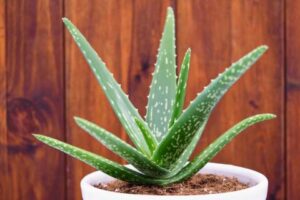
Aloe Vera is an easy-to-care-for and attractive succulent plant. They have firm spiky leaves that shoot out from the center. The leaves are useful as their juice can be used topically to relieve the pain of burns and scrapes. It feels particularly good on a sunburn after a hot afternoon at the beach.
The succulent typically grows to about 1-2 feet but has been known to reach heights of more than 3 feet. It will reach its mature height after three or four years of growth.
Aloe Vera Care Notes
Aloe Vera prefers bright, natural light and will be very happy sitting on a window sill soaking in rays of indirect light. Make sure to water your plant regularly but leave time for the soil to dry in between waterings.
Having adapted to desert soil, Aloe Vera thrives in sandy, poor, soil conditions so they don’t require fertilizer or any special potting soil.
Blue Star Fern
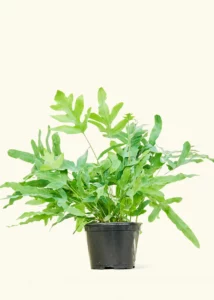 About the Plant
About the Plant
Blue Star Ferns are originally from South America where you can find them growing on trees – although only for support and not for nutrition or moisture. Its bluish-green leaves are elongated and strappy, making them a true centerpiece.
This fern typically only grows to about one foot tall and wide.
Blue Star Fern Care
Like many other plants on this list, bright indirect sunlight is best for the Blue Star Fern. It’s a little more high-maintenance than some of the others when it comes to soil, preferring a peat-based houseplant-specific potting mix.
The soil should be kept consistently moist, but not wet. Unlike other ferns, there is no need to mist this particular type.
There are dozens of houseplants to choose from here at Glover Nursery – this list is just scratching the surface. We encourage you to speak with one of our knowledgeable employees to help you choose the plant that suits your home and needs best!
